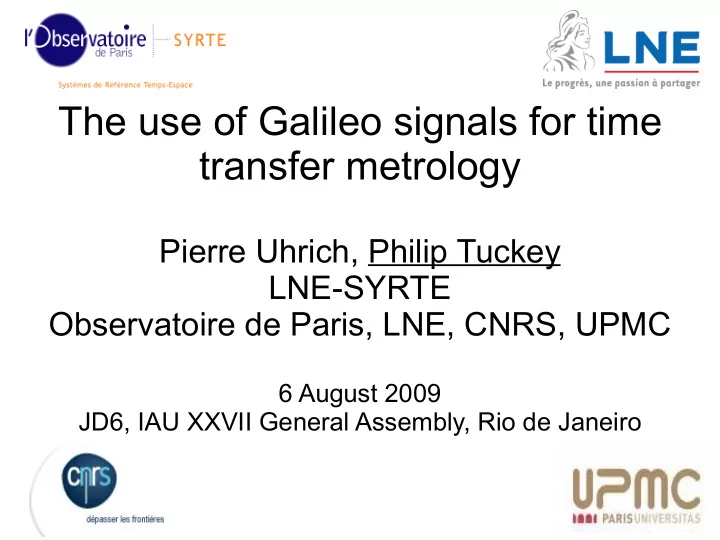

The use of Galileo signals for time transfer metrology Pierre Uhrich, Philip Tuckey LNE-SYRTE Observatoire de Paris, LNE, CNRS, UPMC 6 August 2009 JD6, IAU XXVII General Assembly, Rio de Janeiro
Global Navigation Satellite System (GNSS) time transfer metrology Objective is to measure the time offset between two clocks in distant laboratories, using a GNSS receiver in each laboratory. The GNSS serves only as a transfer system. Used for: ● comparisons between time scales ● comparisons between frequency standards GNSS data essentially always post-processed, with more or less sophistication
GPS and Galileo frequency bands Galileo Joint Undertaking, 2005
Reminder of current GPS usage: signals Signals used L1 (1575.42 MHz): ● C/A code ● P code (“P1”) ● carrier phase L2 (1227.60 Mhz): ● P code (“P2”) ● carrier phase
Reminder of current GPS usage: comparison methods Common view, C/A code ● usually multi-satellite Common view, dual-frequency P-code ● in particular the ionosphere-free linear combination P3 = 2.5457xP1 - 1.5457xP2 All-in-view ● all visible satellites are used to link each receiver to IGS time (common view not needed) Precise Point Positioning (PPP) ● carrier phase and code between two receivers, taking IGS products as fixed data
Galileo ● european GNSS ● 2 experimental satellites currently in orbit ● launch of 4 In Orbit Validation satellites by end 2010 ● fully operational (27+3 satellites) by end 2013 ESA – J. Huart
Galileo services Open Service (OS) Open access, free, dual- frequency Safety of Life (SoL) OS + integrity, authentification, service guarantees Commercial Service (CS) Encrypted commercial data, service guarantees, higher precision Public Regulated Service Encrypted, high precision, robust (PRS) signal, for security applications. Search and Rescue Emergency beacon detection and support service (SAR) return message forwarding
Galileo signals Galileo Joint Undertaking, 2005
Galileo signal usage for time transfer metrology Thus Galileo OS will provide 4 single-frequency signals: ● E5A, E5B, E5, L1F allowing 6 dual-frequency (ionosphere-free) combinations: ● E5A-L1F, E5B-L1F, E5-L1F ● E5A-E5B, E5A-E5, E5-E5B
As with GPS, use of the all-in-view and PPP methods, relying on IGS products, will be beneficial. The combined use of GPS and Galileo (and other GNSS) data will also improve measurements. Timing receivers: provision for external clock and frequency input, existence of a well-defined temporal reference point.
Access to further Galileo signals For GPS, civil user access to the P code signals, in addition to C/A, has been of great importance for the development of applications and for the monitoring of GPS itself. Galileo and future GPS civil signals take account of lessons learned by providing multi-frequency signals, code improvements over C/A, etc. Nevertheless, it is to be expected that scientific user access to Galileo CS (or PRS) signals, in particular on E6, would bring advantages (e.g. multi-frequency combinations for phase ambiguity resolution).
A comment on the CGGTTS format A file format used in the time metrology community for exchanging GPS and GLONASS receiver data for common view, code-based comparisons. For GPS data, C/A, P1, P2 and P3 codes are provided for. In 2006, CCTF approved a modification creating an identifier for Galileo satellites. We also need to define identifiers for the 10 different single-frequency Galileo OS signals and their dual-frequency combinations.
Recent LNE-SYRTE work related to Galileo Participation in the GST to UTC link development. Relative calibration of GPS receivers of participating laboratories: P1 and P2 code delays. Individual P1 and P2 calib- ration uncertainties ~ 0.8 ns -> P3 uncertainty ~ 2.3 ns -> link uncertainty ~ 3.2 ns
Thanks
Future GPS civil signals Future GPS civil signals ● 2005: L2C (L2CM and L2CL) ● 2009: L5C ● 2013: L1C ● 2015: end of civil access to P code
Galileo services and signals E5A E5B E6 L1 E6C E6P L1F L1P OS x x x SoL x x x CS x x x x PRS x x
More information on Galileo signals Typical Chip rate Data rate Encryption C/N 0 Ranging Data Mcps sps dB-Hz E5A 50 10.23 50 No No E5B 50 10.23 250 No Partial E6C 50 5.115 1000 Commercial E6P 50 5.115 1000 Governmental L1F 48 1.023 250 No Partial L1P 48 1.023 250 Governmental Note: E5A + E5B = “E5” signal
Triple-frequency combinations Dual frequency combinations allow the ionospheric contribution to be removed, leaving the geometrical information and errors (code delays, multi-path, receiver noise, phase ambiguities). Triple (and more) frequency combinations allow the geometrical information to also be removed, leaving only the remaining error terms (a frequency-weighted average), which will facilitate their study and mitigation.
Recommend
More recommend